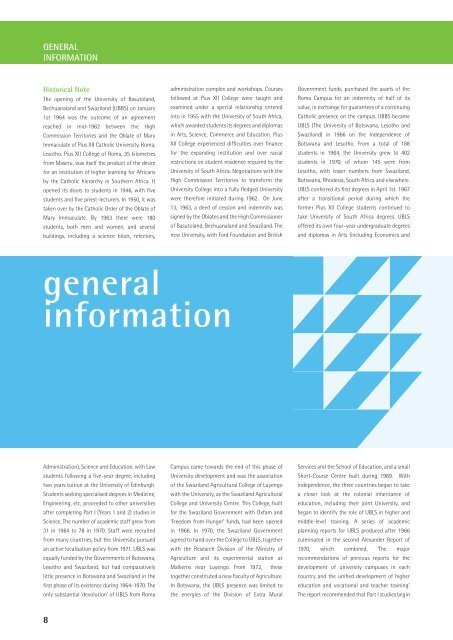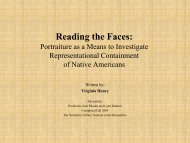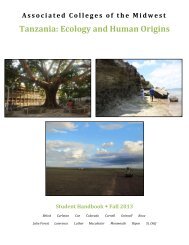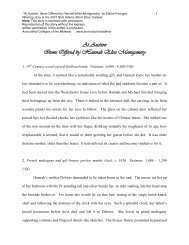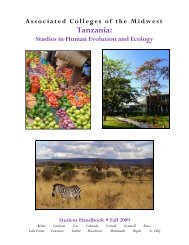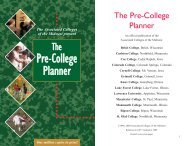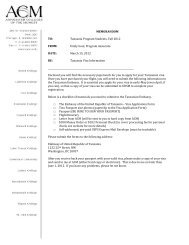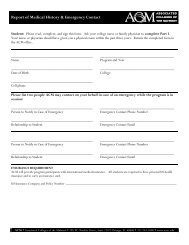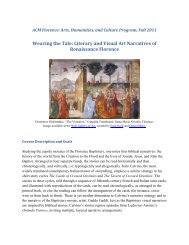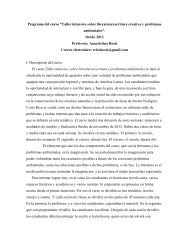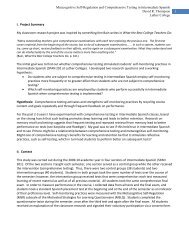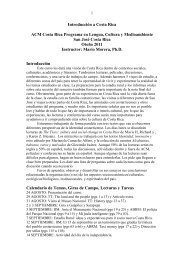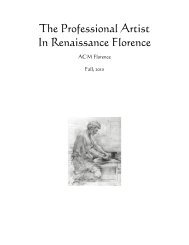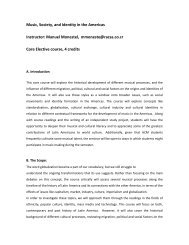academic calendar academic calendar - Associated Colleges of the ...
academic calendar academic calendar - Associated Colleges of the ...
academic calendar academic calendar - Associated Colleges of the ...
Create successful ePaper yourself
Turn your PDF publications into a flip-book with our unique Google optimized e-Paper software.
GENERAL<br />
INFORMATION<br />
Historical Note<br />
The opening <strong>of</strong> <strong>the</strong> University <strong>of</strong> Basutoland,<br />
Bechuanaland and Swaziland (UBBS) on January<br />
1st 1964 was <strong>the</strong> outcome <strong>of</strong> an agreement<br />
reached in mid-1962 between <strong>the</strong> High<br />
Commission Territories and <strong>the</strong> Oblate <strong>of</strong> Mary<br />
Immaculate <strong>of</strong> Pius XII Catholic University, Roma,<br />
Lesotho. Pius XII College <strong>of</strong> Roma, 35 kilometres<br />
from Maseru, was itself <strong>the</strong> product <strong>of</strong> <strong>the</strong> desire<br />
for an institution <strong>of</strong> higher learning for Africans<br />
by <strong>the</strong> Catholic hierarchy in Sou<strong>the</strong>rn Africa. It<br />
opened its doors to students in 1946, with five<br />
students and five priest-lecturers. In 1950, it was<br />
taken over by <strong>the</strong> Catholic Order <strong>of</strong> <strong>the</strong> Oblate <strong>of</strong><br />
Mary Immaculate. By 1963 <strong>the</strong>re were 180<br />
students, both men and women, and several<br />
buildings, including a science block, refectory,<br />
administration complex and workshops. Courses<br />
followed at Pius XII College were taught and<br />
examined under a special relationship entered<br />
into in 1955 with <strong>the</strong> University <strong>of</strong> South Africa,<br />
which awarded students its degrees and diplomas<br />
in Arts, Science, Commerce and Education. Pius<br />
XII College experienced difficulties over finance<br />
for <strong>the</strong> expanding institution and over racial<br />
restrictions on student residence required by <strong>the</strong><br />
University <strong>of</strong> South Africa. Negotiations with <strong>the</strong><br />
High Commission Territories to transform <strong>the</strong><br />
University College into a fully fledged University<br />
were <strong>the</strong>refore initiated during 1962. On June<br />
13, 1963, a deed <strong>of</strong> cession and indemnity was<br />
signed by <strong>the</strong> Oblates and <strong>the</strong> High Commissioner<br />
<strong>of</strong> Basutoland, Bechuanaland and Swaziland. The<br />
new University, with Ford Foundation and British<br />
Government funds, purchased <strong>the</strong> assets <strong>of</strong> <strong>the</strong><br />
Roma Campus for an indemnity <strong>of</strong> half <strong>of</strong> its<br />
value, in exchange for guarantees <strong>of</strong> a continuing<br />
Catholic presence on <strong>the</strong> campus. UBBS became<br />
UBLS (The University <strong>of</strong> Botswana, Lesotho and<br />
Swaziland) in 1966 on <strong>the</strong> Independence <strong>of</strong><br />
Botswana and Lesotho. From a total <strong>of</strong> 188<br />
students in 1964, <strong>the</strong> University grew to 402<br />
students in 1970, <strong>of</strong> whom 145 were from<br />
Lesotho, with lesser numbers from Swaziland,<br />
Botswana, Rhodesia, South Africa and elsewhere.<br />
UBLS conferred its first degrees in April 1st 1967<br />
after a transitional period during which <strong>the</strong><br />
former Pius XII College students continued to<br />
take University <strong>of</strong> South Africa degrees. UBLS<br />
<strong>of</strong>fered its own four-year undergraduate degrees<br />
and diplomas in Arts (including Economics and<br />
general<br />
information<br />
Administration), Science and Education, with Law<br />
students following a five-year degree, including<br />
two years tuition at <strong>the</strong> University <strong>of</strong> Edinburgh.<br />
Students seeking specialised degrees in Medicine,<br />
Engineering, etc, proceeded to o<strong>the</strong>r universities<br />
after completing Part I (Years 1 and 2) studies in<br />
Science. The number <strong>of</strong> <strong>academic</strong> staff grew from<br />
31 in 1964 to 78 in 1970. Staff were recruited<br />
from many countries, but <strong>the</strong> University pursued<br />
an active localisation policy from 1971. UBLS was<br />
equally funded by <strong>the</strong> Governments <strong>of</strong> Botswana,<br />
Lesotho and Swaziland, but had comparatively<br />
little presence in Botswana and Swaziland in <strong>the</strong><br />
first phase <strong>of</strong> its existence during 1964-1970. The<br />
only substantial ‘devolution’ <strong>of</strong> UBLS from Roma<br />
Campus came towards <strong>the</strong> end <strong>of</strong> this phase <strong>of</strong><br />
University development and was <strong>the</strong> association<br />
<strong>of</strong> <strong>the</strong> Swaziland Agricultural College <strong>of</strong> Luyengo<br />
with <strong>the</strong> University, as <strong>the</strong> Swaziland Agricultural<br />
College and University Centre. This College, built<br />
for <strong>the</strong> Swaziland Government with Oxfam and<br />
‘Freedom from Hunger’ funds, had been opened<br />
in 1966. In 1970, <strong>the</strong> Swaziland Government<br />
agreed to hand over <strong>the</strong> College to UBLS, toge<strong>the</strong>r<br />
with <strong>the</strong> Research Division <strong>of</strong> <strong>the</strong> Ministry <strong>of</strong><br />
Agriculture and its experimental station at<br />
Malkerns near Luyengo. From 1972, <strong>the</strong>se<br />
toge<strong>the</strong>r constituted a new Faculty <strong>of</strong> Agriculture.<br />
In Botswana, <strong>the</strong> UBLS presence was limited to<br />
<strong>the</strong> energies <strong>of</strong> <strong>the</strong> Division <strong>of</strong> Extra Mural<br />
Services and <strong>the</strong> School <strong>of</strong> Education, and a small<br />
Short-Course Centre built during 1969. With<br />
independence, <strong>the</strong> three countries began to take<br />
a closer look at <strong>the</strong> colonial inheritance <strong>of</strong><br />
education, including <strong>the</strong>ir joint University, and<br />
began to identify <strong>the</strong> role <strong>of</strong> UBLS in higher and<br />
middle-level training. A series <strong>of</strong> <strong>academic</strong><br />
planning reports for UBLS produced after 1966<br />
culminated in <strong>the</strong> second Alexander Report <strong>of</strong><br />
1970, which combined, ‘The major<br />
recommendations <strong>of</strong> previous reports for <strong>the</strong><br />
development <strong>of</strong> university campuses in each<br />
country and <strong>the</strong> unified development <strong>of</strong> higher<br />
education and vocational and teacher training’.<br />
The report recommended that Part I studies begin


